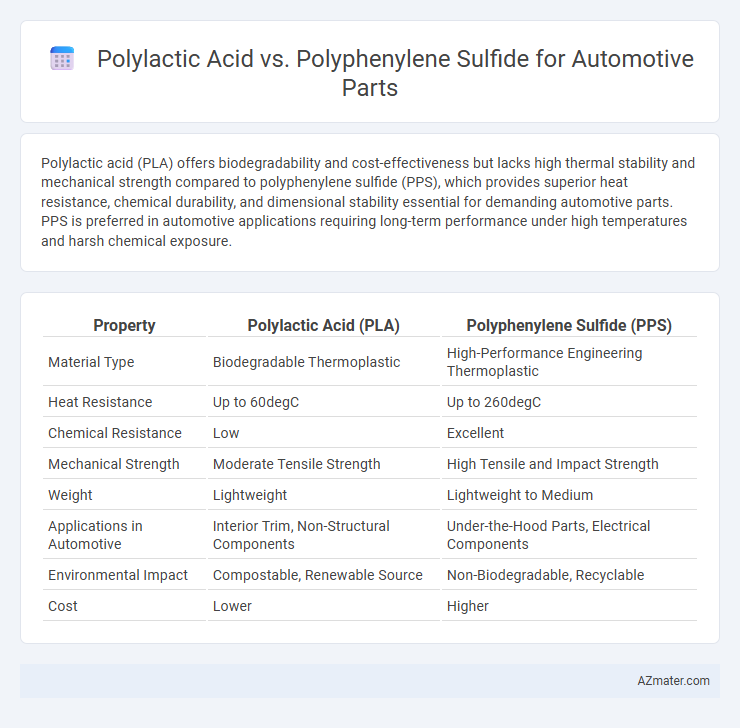Polylactic acid (PLA) offers biodegradability and cost-effectiveness but lacks high thermal stability and mechanical strength compared to polyphenylene sulfide (PPS), which provides superior heat resistance, chemical durability, and dimensional stability essential for demanding automotive parts. PPS is preferred in automotive applications requiring long-term performance under high temperatures and harsh chemical exposure.
Table of Comparison
| Property | Polylactic Acid (PLA) | Polyphenylene Sulfide (PPS) |
|---|---|---|
| Material Type | Biodegradable Thermoplastic | High-Performance Engineering Thermoplastic |
| Heat Resistance | Up to 60degC | Up to 260degC |
| Chemical Resistance | Low | Excellent |
| Mechanical Strength | Moderate Tensile Strength | High Tensile and Impact Strength |
| Weight | Lightweight | Lightweight to Medium |
| Applications in Automotive | Interior Trim, Non-Structural Components | Under-the-Hood Parts, Electrical Components |
| Environmental Impact | Compostable, Renewable Source | Non-Biodegradable, Recyclable |
| Cost | Lower | Higher |
Introduction to Polylactic Acid (PLA) and Polyphenylene Sulfide (PPS)
Polylactic Acid (PLA) is a biodegradable thermoplastic derived from renewable resources like corn starch, known for its excellent clarity and ease of processing, making it suitable for lightweight automotive parts with environmental benefits. Polyphenylene Sulfide (PPS) is a high-performance, heat-resistant engineering thermoplastic with exceptional chemical resistance and dimensional stability, ideal for demanding under-the-hood automotive components. Comparing PLA and PPS highlights the trade-offs between sustainability and high mechanical and thermal performance in automotive part applications.
Key Material Properties: PLA vs PPS
Polylactic acid (PLA) offers excellent biodegradability and a high tensile strength of around 50-70 MPa, making it suitable for lightweight automotive components with moderate temperature exposure up to 60degC. Polyphenylene sulfide (PPS) demonstrates superior thermal stability, maintaining performance at continuous use temperatures exceeding 200degC, along with outstanding chemical resistance and dimensional stability under harsh automotive conditions. The choice between PLA and PPS hinges on application-specific requirements, balancing biodegradable properties and moderate mechanical strength against high temperature tolerance and chemical durability.
Thermal Stability Comparison in Automotive Environments
Polylactic acid (PLA) exhibits lower thermal stability, typically degrading above 180degC, which limits its use in high-temperature automotive environments. Polyphenylene sulfide (PPS) maintains integrity at temperatures exceeding 260degC, making it highly suitable for under-the-hood applications requiring sustained heat resistance. PPS's superior thermal stability contributes to enhanced durability and performance in automotive parts exposed to continuous heat cycles and aggressive conditions.
Mechanical Strength and Durability for Auto Applications
Polylactic acid (PLA) offers biodegradability and moderate mechanical strength but lacks the high tensile strength and heat resistance required for demanding automotive parts, limiting its durability under prolonged mechanical stress. Polyphenylene sulfide (PPS), with its superior mechanical strength, excellent chemical resistance, and stability at high temperatures, provides enhanced durability and performance in automotive applications such as under-the-hood components and structural parts. PPS's ability to retain mechanical properties under thermal cycling and chemical exposure makes it a preferred choice for long-lasting automotive components compared to PLA.
Chemical Resistance: PLA vs PPS in Automotive Use
Polyphenylene sulfide (PPS) demonstrates superior chemical resistance compared to polylactic acid (PLA) when used in automotive parts, especially under exposure to fuels, oils, and aggressive solvents. PPS maintains structural integrity and performance at elevated temperatures up to 260degC, whereas PLA degrades more rapidly under such conditions due to its lower thermal and chemical stability. Consequently, PPS is preferred for critical automotive components requiring long-term durability and resistance to harsh chemical environments.
Weight Considerations and Fuel Efficiency Impact
Polylactic acid (PLA) offers a lightweight alternative to polyphenylene sulfide (PPS) in automotive parts, significantly reducing component mass and enhancing overall vehicle fuel efficiency. PPS, while heavier, provides superior thermal stability and chemical resistance, which may limit its substitution in specific high-performance applications despite the weight penalty. Utilizing PLA can lead to meaningful reductions in fuel consumption through decreased vehicle weight, supporting sustainable automotive design without compromising structural integrity in less demanding environments.
Manufacturing Processes and Tooling Requirements
Polylactic acid (PLA) offers ease of processing through injection molding and 3D printing, requiring standard tooling due to its lower melting point and biodegradable nature, making it suitable for prototype and low-load automotive parts. Polyphenylene sulfide (PPS) demands high-temperature resistant tooling and specialized injection molding equipment to withstand its high melting point and chemical resistance, enabling the production of durable, high-performance automotive components. Manufacturing PLA typically involves lower energy consumption and faster cycle times compared to PPS, which requires precise thermal management and robust molds to maintain dimensional stability in critical automotive applications.
Environmental Impact and Sustainability Analysis
Polylactic acid (PLA) offers a significant environmental advantage in automotive parts due to its biodegradability and origin from renewable resources like corn starch, reducing reliance on fossil fuels and lowering carbon footprint. Polyphenylene sulfide (PPS), while highly durable and resistant to heat and chemicals, is petroleum-based, resulting in greater environmental impact through resource extraction and non-biodegradability. Sustainability analysis favors PLA for minimizing end-of-life waste and enabling compostability, whereas PPS excels in longevity and performance but poses challenges in recycling and environmental persistence.
Cost Efficiency in Automotive Part Production
Polylactic acid (PLA) offers cost efficiency in automotive part production due to its renewable sources and lower processing temperatures, reducing energy consumption. Polyphenylene sulfide (PPS) provides superior mechanical properties and chemical resistance, but its higher raw material cost and processing complexity increase overall production expenses. Selecting PLA is advantageous for eco-friendly, low-cost applications, while PPS suits high-performance parts where durability justifies the investment.
Application Suitability: PLA and PPS in Real-World Automotive Parts
Polyphenylene sulfide (PPS) demonstrates superior thermal stability and chemical resistance, making it ideal for under-the-hood automotive components such as electrical connectors, fuel system parts, and sensor housings that require durability in high-temperature environments. Polylactic acid (PLA), a biodegradable polymer, is more suitable for interior applications like trim panels and non-structural decorative elements, where mechanical strength and heat resistance are less critical. The selection between PPS and PLA hinges on the specific automotive part requirements, balancing performance characteristics and environmental impact.

Infographic: Polylactic acid vs Polyphenylene sulfide for Automotive Part
 azmater.com
azmater.com